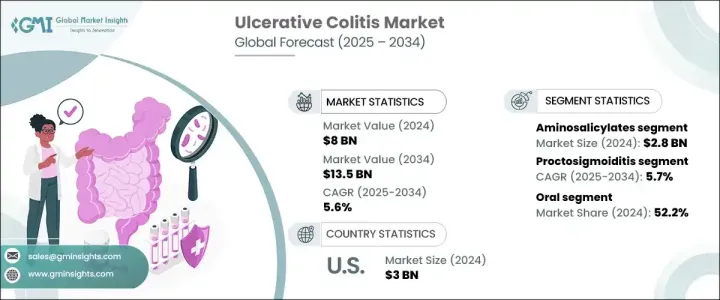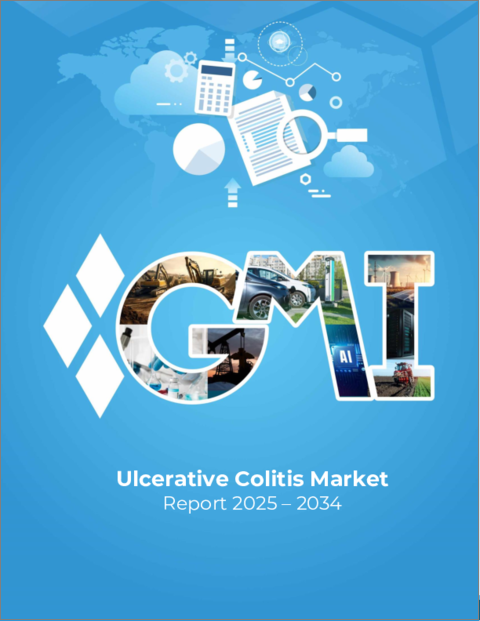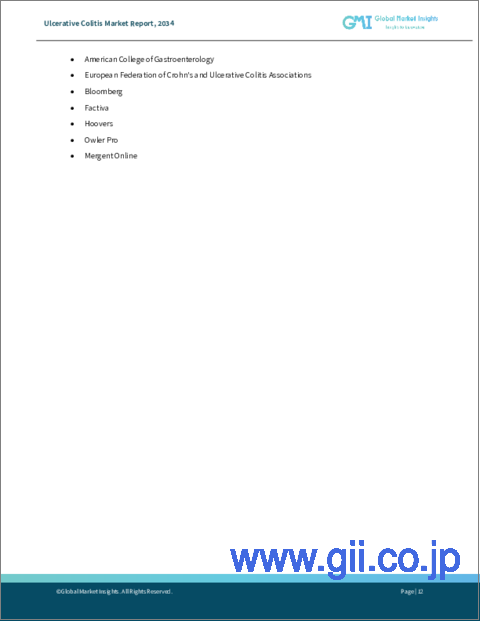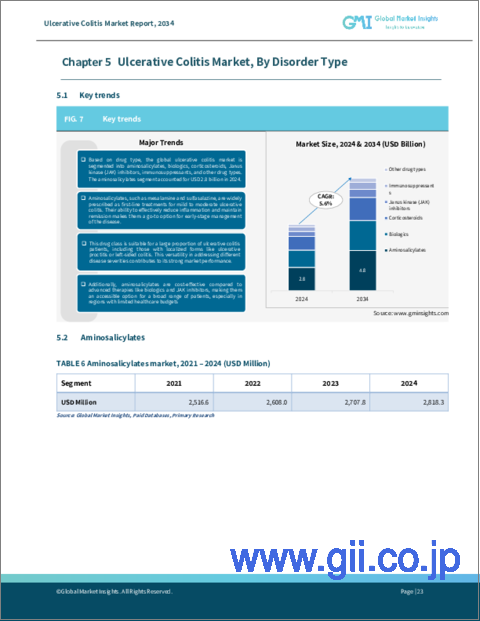|
|
市場調査レポート
商品コード
1684689
潰瘍性大腸炎市場の機会、成長促進要因、産業動向分析、2025年~2034年予測Ulcerative Colitis Market Opportunity, Growth Drivers, Industry Trend Analysis, and Forecast 2025 - 2034 |
||||||
カスタマイズ可能
|
|||||||
| 潰瘍性大腸炎市場の機会、成長促進要因、産業動向分析、2025年~2034年予測 |
|
出版日: 2025年01月14日
発行: Global Market Insights Inc.
ページ情報: 英文 135 Pages
納期: 2~3営業日
|
全表示
- 概要
- 目次
潰瘍性大腸炎の世界市場は2024年に80億米ドルに達し、2025年から2034年までのCAGRは5.6%と予測され、着実に拡大するとみられています。
この成長は、都市化、食習慣の進化、環境の変化により増加し続ける潰瘍性大腸炎の有病率の増加が大きな要因となっています。欧米化したライフスタイルを採用する人が増えるにつれ、食生活の乱れ、ストレス、汚染などの要因が潰瘍性大腸炎を含む炎症性腸疾患(IBD)の罹患率を高める一因となっています。世界中で数百万人が罹患しており、効果的かつ長期的な治療ソリューションに対する需要が高まっています。

医学研究の開発により、より優れた疾患管理と患者の予後改善をもたらす新規治療薬が開発されています。製薬会社は、より的を絞った治療を提供するため、生物学的製剤やJAK阻害剤などの新しい製剤に積極的に投資しています。さらに、ヘルスケアシステムは早期診断と早期介入に重点を置いており、患者の意識向上とタイムリーな医療につながっています。個別化医療や併用療法など、患者中心の治療計画への注目が高まっていることも、市場内の技術革新を促進しています。規制当局による新薬の承認や既存薬の適応拡大がさらに市場の成長に寄与しており、医薬品メーカーやヘルスケアプロバイダーに有利な機会を生み出しています。
| 市場範囲 | |
|---|---|
| 開始年 | 2024 |
| 予測年 | 2025-2034 |
| 開始金額 | 80億米ドル |
| 予測金額 | 135億米ドル |
| CAGR | 5.6% |
市場は薬剤の種類別にアミノサリチル酸塩、生物学的製剤、コルチコステロイド、ヤヌスキナーゼ(JAK)阻害剤、免疫抑制剤、その他に分類されます。2024年には、軽度から中等度の潰瘍性大腸炎の第一選択治療薬として広く使用されていることを反映して、アミノサリチル酸塩セグメントは28億米ドルを生み出しました。これらの抗炎症薬は、症状の軽減と寛解の維持に非常に効果的であるため、多くの患者にとって好ましい選択肢となっています。重大な副作用を伴わずに長期的な緩和をもたらすその能力は、市場での強い存在感を示す一因となっています。軽症例の診断率が上昇する中、アミノサリチル酸塩の需要は引き続き堅調であり、市場での優位性が確保されています。
投与方法は、患者の嗜好や治療コンプライアンスにおいて重要な役割を果たしています。市場は経口療法と注射療法に区分され、2024年のシェアは経口療法が52.2%を占めています。アミノサリチル酸塩、JAK阻害剤、免疫抑制剤など、一般的に処方される治療の多くは経口剤で入手可能であり、患者にとって便利な選択肢となっています。自己投与の容易さ、費用対効果、頻繁な受診の必要性の減少などの点から、経口薬は好ましい選択肢となっています。製薬会社はドラッグデリバリーシステムを改良し続け、経口治療のバイオアベイラビリティと有効性を高めており、このセグメントの市場での地位をさらに強化しています。
米国の潰瘍性大腸炎市場は2024年に30億米ドルと評価され、世界市場成長への最大貢献地域のひとつとなりました。米国では潰瘍性大腸炎の有病率が高いため、高度な治療オプションに対する需要が高まっています。確立されたヘルスケアインフラ、研究開発資金の増加、疾患啓発への積極的なアプローチが市場拡大を加速させています。
目次
第1章 調査手法と調査範囲
第2章 エグゼクティブサマリー
第3章 業界洞察
- エコシステム分析
- 業界への影響要因
- 促進要因
- 潰瘍性大腸炎の有病率の増加
- 治療選択肢の拡大
- 認知度と診断の向上
- 業界の潜在的リスク&課題
- 高い治療費
- 副作用と安全性への懸念
- 促進要因
- 成長可能性分析
- 規制状況
- パイプライン分析
- ポーターの分析
- PESTEL分析
第4章 競合情勢
- イントロダクション
- 企業マトリックス分析
- 主要市場プレーヤーの競合分析
- 競合のポジショニングマトリックス
- 戦略ダッシュボード
第5章 市場推計・予測:薬剤タイプ別、2021年~2034年
- 主要動向
- アミノサリチル酸塩
- 生物製剤
- コルチコステロイド
- ヤヌスキナーゼ(JAK)阻害薬
- 免疫抑制剤
- その他の薬剤
第6章 市場推計・予測:疾患タイプ別、2021年~2034年
- 主要動向
- 肛門直腸炎
- 潰瘍性直腸炎
- 左側大腸炎
- 膵炎または万能性大腸炎
- 劇症型大腸炎
第7章 市場推計・予測:投与経路別、2021年~2034年
- 主要動向
- 経口
- 注射可能
第8章 市場推計・予測:流通チャネル別、2021年~2034年
- 主要動向
- 病院薬局
- 小売薬局
- オンライン薬局
第9章 市場推計・予測:地域別、2021年~2034年
- 主要動向
- 北米
- 米国
- カナダ
- 欧州
- ドイツ
- 英国
- フランス
- イタリア
- スペイン
- オランダ
- アジア太平洋
- 中国
- 日本
- インド
- オーストラリア
- 韓国
- ラテンアメリカ
- ブラジル
- メキシコ
- アルゼンチン
- 中東・アフリカ
- 南アフリカ
- サウジアラビア
- アラブ首長国連邦
第10章 企業プロファイル
- AbbVie
- Bausch Health Companies
- Bristol Myers Squibb
- Eli Lilly and Company
- Johnson &Johnson
- Merck
- Mitsubishi Tanabe Pharma Corporation
- Novartis
- Pfizer
- Sun Pharmaceutical Industries
- Takeda Pharmaceutical Company Limited
- Teva Pharmaceutical Industries
The Global Ulcerative Colitis Market reached USD 8 billion in 2024 and is set to experience steady expansion, with a projected CAGR of 5.6% from 2025 to 2034. This growth is largely fueled by the increasing prevalence of ulcerative colitis, which continues to rise due to urbanization, evolving dietary habits, and environmental changes. As more people adopt Westernized lifestyles, factors such as poor diet, stress, and pollution have contributed to a higher incidence of inflammatory bowel diseases (IBD), including ulcerative colitis. With millions affected worldwide, the demand for effective and long-term treatment solutions is on the rise.

Advancements in medical research have led to the development of novel therapies that offer better disease management and improved patient outcomes. Pharmaceutical companies are actively investing in new drug formulations, including biologics and JAK inhibitors, to provide more targeted treatments. Additionally, healthcare systems are placing greater emphasis on early diagnosis and intervention, leading to increased patient awareness and timely medical care. The growing focus on patient-centric treatment plans, including personalized medicine and combination therapies, is also driving innovation within the market. Regulatory approvals for new drugs and expanded indications for existing medications are further contributing to market growth, creating lucrative opportunities for drug manufacturers and healthcare providers.
| Market Scope | |
|---|---|
| Start Year | 2024 |
| Forecast Year | 2025-2034 |
| Start Value | $8 Billion |
| Forecast Value | $13.5 Billion |
| CAGR | 5.6% |
The market is categorized by drug type into aminosalicylates, biologics, corticosteroids, Janus kinase (JAK) inhibitors, immunosuppressants, and others. In 2024, the aminosalicylates segment generated USD 2.8 billion, reflecting its widespread use as a first-line treatment for mild to moderate ulcerative colitis. These anti-inflammatory drugs are highly effective in reducing symptoms and maintaining remission, making them a preferred option for many patients. Their ability to provide long-term relief without significant side effects has contributed to their strong market presence. With the increasing diagnosis rate of mild cases, the demand for aminosalicylates remains robust, ensuring their continued dominance in the market.
The method of administration plays a critical role in patient preference and treatment compliance. The market is segmented into oral and injectable therapies, with oral medications capturing a 52.2% share in 2024. Many commonly prescribed treatments, including aminosalicylates, JAK inhibitors, and immunosuppressants, are available in oral formulations, making them a convenient option for patients. The ease of self-administration, cost-effectiveness, and reduced need for frequent medical visits make oral drugs the preferred choice. Pharmaceutical companies continue to refine drug delivery systems, enhancing the bioavailability and efficacy of oral treatments, further strengthening this segment's position in the market.
The United States ulcerative colitis market was valued at USD 3 billion in 2024, making it one of the largest regional contributors to global market growth. The high prevalence of ulcerative colitis in the U.S. has driven significant demand for advanced treatment options. A well-established healthcare infrastructure, increased funding for research and development, and a proactive approach to disease awareness have accelerated market expansion.
Table of Contents
Chapter 1 Methodology and Scope
- 1.1 Market scope and definition
- 1.2 Research design
- 1.2.1 Research approach
- 1.2.2 Data collection methods
- 1.3 Base estimates and calculations
- 1.3.1 Base year calculation
- 1.3.2 Key trends for market estimation
- 1.4 Forecast model
- 1.5 Primary research and validation
- 1.5.1 Primary sources
- 1.5.2 Data mining sources
Chapter 2 Executive Summary
- 2.1 Industry 3600 synopsis
Chapter 3 Industry Insights
- 3.1 Industry ecosystem analysis
- 3.2 Industry impact forces
- 3.2.1 Growth drivers
- 3.2.1.1 Increasing prevalence of ulcerative colitis
- 3.2.1.2 Expanding treatment options
- 3.2.1.3 Increasing awareness and diagnosis
- 3.2.2 Industry pitfalls and challenges
- 3.2.2.1 High treatment costs
- 3.2.2.2 Side effects and safety concerns
- 3.2.1 Growth drivers
- 3.3 Growth potential analysis
- 3.4 Regulatory landscape
- 3.5 Pipeline analysis
- 3.6 Porter's analysis
- 3.7 PESTEL analysis
Chapter 4 Competitive Landscape, 2024
- 4.1 Introduction
- 4.2 Company matrix analysis
- 4.3 Competitive analysis of major market players
- 4.4 Competitive positioning matrix
- 4.5 Strategy dashboard
Chapter 5 Market Estimates and Forecast, By Drug Type, 2021 – 2034 ($ Mn)
- 5.1 Key trends
- 5.2 Aminosalicylates
- 5.3 Biologics
- 5.4 Corticosteroids
- 5.5 Janus kinase (JAK) inhibitors
- 5.6 Immunosuppressants
- 5.7 Other drug types
Chapter 6 Market Estimates and Forecast, By Disease Type, 2021 – 2034 ($ Mn)
- 6.1 Key trends
- 6.2 Proctosigmoiditis
- 6.3 Ulcerative proctitis
- 6.4 Left-sided colitis
- 6.5 Pancolitis or universal colitis
- 6.6 Fulminant colitis
Chapter 7 Market Estimates and Forecast, By Route of Administration, 2021 – 2034 ($ Mn)
- 7.1 Key trends
- 7.2 Oral
- 7.3 Injectable
Chapter 8 Market Estimates and Forecast, By Distribution Channel, 2021 – 2034 ($ Mn)
- 8.1 Key trends
- 8.2 Hospital pharmacies
- 8.3 Retail pharmacies
- 8.4 Online pharmacies
Chapter 9 Market Estimates and Forecast, By Region, 2021 – 2034 ($ Mn)
- 9.1 Key trends
- 9.2 North America
- 9.2.1 U.S.
- 9.2.2 Canada
- 9.3 Europe
- 9.3.1 Germany
- 9.3.2 UK
- 9.3.3 France
- 9.3.4 Italy
- 9.3.5 Spain
- 9.3.6 Netherlands
- 9.4 Asia Pacific
- 9.4.1 China
- 9.4.2 Japan
- 9.4.3 India
- 9.4.4 Australia
- 9.4.5 South Korea
- 9.5 Latin America
- 9.5.1 Brazil
- 9.5.2 Mexico
- 9.5.3 Argentina
- 9.6 Middle East and Africa
- 9.6.1 South Africa
- 9.6.2 Saudi Arabia
- 9.6.3 UAE
Chapter 10 Company Profiles
- 10.1 AbbVie
- 10.2 Bausch Health Companies
- 10.3 Bristol Myers Squibb
- 10.4 Eli Lilly and Company
- 10.5 Johnson & Johnson
- 10.6 Merck
- 10.7 Mitsubishi Tanabe Pharma Corporation
- 10.8 Novartis
- 10.9 Pfizer
- 10.10 Sun Pharmaceutical Industries
- 10.11 Takeda Pharmaceutical Company Limited
- 10.12 Teva Pharmaceutical Industries





